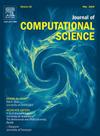A Bernstein–Bézier finite element method with perfectly matched layer for refraction and diffraction of waves in coastal regions
IF 3.7
3区 计算机科学
Q2 COMPUTER SCIENCE, INTERDISCIPLINARY APPLICATIONS
引用次数: 0
Abstract
The aim of this paper is to effectively solve wave problems, governed by the linear elliptic mild-slope equation, on unstructured triangular meshes based on the Bernstein–Bézier finite element method. The present model takes into account non-uniform bathymetry and enables to accurately describe wave agitation problems and it copes with the pollution effect. A domain truncation method relying on the Perfectly Matched Layer (PML) concept is performed to address the issues related to open region domains. The proposed PML model uses a non-standard weak form of the truncated mild-slope equation to handle the incident wave field weakly and takes into account external bathymetry effects. A low-complexity procedure, exploiting the tensorial property of Bernstein polynomials in conjunction with the sum factorization method, is applied to set up the local high-order finite element matrices. Additionally, static condensation is applied element-wise to reduce the memory requirements. To avoid further sources of errors due to the interpolation of geometry, an accurate description of curved elements is adopted based on a blending map method. An analysis of -convergence using radial PML is conducted by investigating a wave scattering problem by a circular island, where the bathymetry is initially assumed to be constant, and then including a parabolic shoal. The conditioning of the system matrix is also analyzed. The results clearly demonstrate that Bernstein–Bézier finite element method with radial PML considerably reduces memory requirements while maintaining targeted accuracy. A comparison study in the case of constant bathymetry shows that both radial and Cartesian PMLs yield similar performance in terms of accuracy. To further assess the efficiency of our model, a benchmark dealing with wave scattering by an elliptical shoal is investigated to demonstrate the performance of Cartesian PML with exterior bathymetry effects. Our numerical results are therefore compared with available experimental data as well as those found in the literature.
沿海地区波浪折射和衍射的完全匹配层的bernstein - bsamzier有限元方法
本文的目的是基于bernstein - bassazier有限元法,在非结构三角形网格上有效求解由线性椭圆型缓坡方程控制的波动问题。该模型考虑了非均匀水深,能够准确地描述波浪搅拌问题,并处理了污染效应。提出了一种基于完全匹配层(PML)概念的域截断方法来解决开放区域域的相关问题。所提出的PML模型采用截断缓坡方程的非标准弱形式对入射波场进行弱处理,并考虑了外部测深效应。利用Bernstein多项式的张量性质,结合和分解法,采用一种低复杂度的方法建立了局部高阶有限元矩阵。此外,静态压缩应用于元素,以减少内存需求。为了避免几何插值带来的进一步误差来源,采用了基于混合映射的曲线元素精确描述方法。通过研究一个圆形岛屿的波散射问题,首先假设水深为常数,然后包括抛物线浅滩,利用径向PML分析了h收敛性。分析了系统矩阵的条件。结果清楚地表明,径向PML的bernstein - bsamzier有限元法在保持目标精度的同时,大大降低了内存需求。在恒定水深情况下的比较研究表明,径向和直角pml在精度方面具有相似的性能。为了进一步评估我们的模型的效率,研究了一个处理椭圆浅滩波浪散射的基准,以验证具有外部测深效应的笛卡尔PML的性能。因此,我们的数值结果与现有的实验数据以及文献中的数据进行了比较。
本文章由计算机程序翻译,如有差异,请以英文原文为准。
求助全文
约1分钟内获得全文
求助全文
来源期刊

Journal of Computational Science
COMPUTER SCIENCE, INTERDISCIPLINARY APPLICATIONS-COMPUTER SCIENCE, THEORY & METHODS
CiteScore
5.50
自引率
3.00%
发文量
227
审稿时长
41 days
期刊介绍:
Computational Science is a rapidly growing multi- and interdisciplinary field that uses advanced computing and data analysis to understand and solve complex problems. It has reached a level of predictive capability that now firmly complements the traditional pillars of experimentation and theory.
The recent advances in experimental techniques such as detectors, on-line sensor networks and high-resolution imaging techniques, have opened up new windows into physical and biological processes at many levels of detail. The resulting data explosion allows for detailed data driven modeling and simulation.
This new discipline in science combines computational thinking, modern computational methods, devices and collateral technologies to address problems far beyond the scope of traditional numerical methods.
Computational science typically unifies three distinct elements:
• Modeling, Algorithms and Simulations (e.g. numerical and non-numerical, discrete and continuous);
• Software developed to solve science (e.g., biological, physical, and social), engineering, medicine, and humanities problems;
• Computer and information science that develops and optimizes the advanced system hardware, software, networking, and data management components (e.g. problem solving environments).
 求助内容:
求助内容: 应助结果提醒方式:
应助结果提醒方式:


